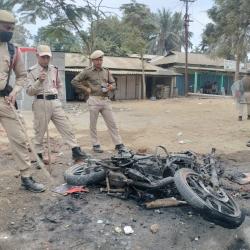Indian Railways have planned early electrification of entire tracks in the country without imagining the problems to be faced by the people in future. So long the government’s scheme to electrify all the villages of the country is not properly implemented and most of villages are still waiting to see the light of electricity. Side effects of the Railway’s hasty decisions may put the country in great problems. The government should re-think about the plans and programmes and should not try to implement it for political gains.
It may be noted that every electric locomotive of 4.5 MW (6000 HP) deprives 15,000 households of their electricity needs and 14.7 percent villages in the country are yet to get electricity.
Every electric locomotive of 4.5 MW introduces 4,500 highly inefficient small generating sets, which cause more pollution and consume six times more fuel than a diesel locomotive.
World’s modern and advance economies like USA and Canada have less than one percent electrification against Indian Railway’s 41.7 percent.
All profit making Railways of the world are having predominately diesel traction, while all loss making Railways are predominantly electric traction Railways.
Diesel loco hauled passenger trains are 41 percent cheaper than electric hauled trains.
Electric traction requires huge capital investment of Rs.63 crore per loco in overhead wires, Transmission lines, and power plants as against Rs.3 crore only on diesel traction.
Energy bill of Railways for the year 1998-99 was more than Rs.2800 crore for hauling about sixty percent freight traffic and fifty percent passenger traffic against fuel bill of about Rs1500 crore for the balance BG traffic.
As per Executive Directors’ Committee set up by the Board in 1996, the Break even level is 49.72 GMT (Gross Million Tonnes) per annum. Sections currently being electrified have 5-10 GMT of traffic density.
For the price of 100 energy units (kWh) one could buy10.9 liters of HSD in 1963 against 41.2 lures in 1999. This amounts to a 16 times hike in diesel prices while electricity prices have gone up by 60 times in the same period.
Gujral Committee of 1990 recommended 214 kilometers of electrification per year. Current rate is 2.33 times.
Electrification projects are being justified based on inflated rate of return (ROR) worked out on the basis of wrong assumptions- benefits are overstated and costs understated.
As per Railway Board’s norms, projects with a minimum ROR of 14 percent should be undertaken (Railways are borrowing money through IRFC at about 17-18 percent). Electrification projects such as Ludhiana-Amritsar and Patna-Gaya which are now being undertaken are having RORs of only 4 percent and 6 percent respectively, even as per calculations made by the Central Organization for Railway Electrification taking wrong data. The actual RORs calculated on the basis of correct figures for expenditure as well as benefits turn out to the highly negative. In the case of Ludhiana-Amritsar electrification project, Planning Commission had also commented that such projects are likely to eat into the national wealth rather than generate additional wealth.
No post-complexion evaluation of benefits was ever done on any of the electrification projects. World Bank report of 1995 concluded that the rate of return on two of the busiest sections of Indian Railways i.e. Vijaywada-Balharshah and Jhansi-Itarsi was on two percent and nine percent as against the projections of 41 percent and 23 percent respectively.
Fifty three percent of total price of HSD goes to the government exchequer in the form of various levies-Customs/Excise, Cess etc.
If the losses of SEBs are amortized, the cost of energy to the consumer including Railways will be much higher.
Indian Railways are losing Rs.1900 crore per year on account of electrification, Rs.600 crore per year as running losses (due to higher operating costs on electric traction as compared to diesel traction), besides Rs1300 crore per year as the interest on capital cost of electrification.
Unviable electrification is resulting in crippling of railways fiancés. The operating ratio (expenditure divided by earnings) for Indian Railways, which was 82.5 per cent in 1995-96 has deteriorated to 98.8 percent for 2000-01 (as budgeted) even while Railways will be deferring their dividend payment to the Central Government during the year. In case dividend is paid, operating ratio would be beyond 100.
When electrification projects have ceased to be justified based on breakeven level of traffic of 49.7 GMT as well as 14 percent ROR, other reasons are being given to undertake these projects. For instance, electrification of Ludhiana-Amritsar section is sought to be justified for security reasons. The truth is that overhead wires as well as other traction installations, such as sub-stations etc; are highly vulnerable to attacks by terrorists. Similarly, electrification of Patna-Gaya section is ostensibly being done to cater for suburban passenger traffic. This section, which is a single line section, hardly has any traffic and carries only five pairs of passenger trains everyday and just one goods train in a day. Diesel traction in any case is cheaper for passenger services.
Contrary to popular perception electric traction is more polluting than diesel traction.
The ‘green house’ gases emission in case of power generation from coal is 26 percent higher than that for a diesel locomotive for the same amount of power generated (UNDP study). Considering the transmission losses associated with the distribution of power, electric traction is about 65 percent more polluting as compared to diesel traction.
Generation of one MW of power requires ten tones of coal everyday. Since coal in India has an ash content of 40 percent, this results in generation of 4 tonnes of coal ash everyday. Thus, one electric locomotive requiring 4.5 MW of power is responsible for generating of 18 tonnes of coal ash everyday.
It may be noted that every electric locomotive of 4.5 MW (6000 HP) deprives 15,000 households of their electricity needs and 14.7 percent villages in the country are yet to get electricity.
Every electric locomotive of 4.5 MW introduces 4,500 highly inefficient small generating sets, which cause more pollution and consume six times more fuel than a diesel locomotive.
World’s modern and advance economies like USA and Canada have less than one percent electrification against Indian Railway’s 41.7 percent.
All profit making Railways of the world are having predominately diesel traction, while all loss making Railways are predominantly electric traction Railways.
Diesel loco hauled passenger trains are 41 percent cheaper than electric hauled trains.
Electric traction requires huge capital investment of Rs.63 crore per loco in overhead wires, Transmission lines, and power plants as against Rs.3 crore only on diesel traction.
Energy bill of Railways for the year 1998-99 was more than Rs.2800 crore for hauling about sixty percent freight traffic and fifty percent passenger traffic against fuel bill of about Rs1500 crore for the balance BG traffic.
As per Executive Directors’ Committee set up by the Board in 1996, the Break even level is 49.72 GMT (Gross Million Tonnes) per annum. Sections currently being electrified have 5-10 GMT of traffic density.
For the price of 100 energy units (kWh) one could buy10.9 liters of HSD in 1963 against 41.2 lures in 1999. This amounts to a 16 times hike in diesel prices while electricity prices have gone up by 60 times in the same period.
Gujral Committee of 1990 recommended 214 kilometers of electrification per year. Current rate is 2.33 times.
Electrification projects are being justified based on inflated rate of return (ROR) worked out on the basis of wrong assumptions- benefits are overstated and costs understated.
As per Railway Board’s norms, projects with a minimum ROR of 14 percent should be undertaken (Railways are borrowing money through IRFC at about 17-18 percent). Electrification projects such as Ludhiana-Amritsar and Patna-Gaya which are now being undertaken are having RORs of only 4 percent and 6 percent respectively, even as per calculations made by the Central Organization for Railway Electrification taking wrong data. The actual RORs calculated on the basis of correct figures for expenditure as well as benefits turn out to the highly negative. In the case of Ludhiana-Amritsar electrification project, Planning Commission had also commented that such projects are likely to eat into the national wealth rather than generate additional wealth.
No post-complexion evaluation of benefits was ever done on any of the electrification projects. World Bank report of 1995 concluded that the rate of return on two of the busiest sections of Indian Railways i.e. Vijaywada-Balharshah and Jhansi-Itarsi was on two percent and nine percent as against the projections of 41 percent and 23 percent respectively.
Fifty three percent of total price of HSD goes to the government exchequer in the form of various levies-Customs/Excise, Cess etc.
If the losses of SEBs are amortized, the cost of energy to the consumer including Railways will be much higher.
Indian Railways are losing Rs.1900 crore per year on account of electrification, Rs.600 crore per year as running losses (due to higher operating costs on electric traction as compared to diesel traction), besides Rs1300 crore per year as the interest on capital cost of electrification.
Unviable electrification is resulting in crippling of railways fiancés. The operating ratio (expenditure divided by earnings) for Indian Railways, which was 82.5 per cent in 1995-96 has deteriorated to 98.8 percent for 2000-01 (as budgeted) even while Railways will be deferring their dividend payment to the Central Government during the year. In case dividend is paid, operating ratio would be beyond 100.
When electrification projects have ceased to be justified based on breakeven level of traffic of 49.7 GMT as well as 14 percent ROR, other reasons are being given to undertake these projects. For instance, electrification of Ludhiana-Amritsar section is sought to be justified for security reasons. The truth is that overhead wires as well as other traction installations, such as sub-stations etc; are highly vulnerable to attacks by terrorists. Similarly, electrification of Patna-Gaya section is ostensibly being done to cater for suburban passenger traffic. This section, which is a single line section, hardly has any traffic and carries only five pairs of passenger trains everyday and just one goods train in a day. Diesel traction in any case is cheaper for passenger services.
Contrary to popular perception electric traction is more polluting than diesel traction.
The ‘green house’ gases emission in case of power generation from coal is 26 percent higher than that for a diesel locomotive for the same amount of power generated (UNDP study). Considering the transmission losses associated with the distribution of power, electric traction is about 65 percent more polluting as compared to diesel traction.
Generation of one MW of power requires ten tones of coal everyday. Since coal in India has an ash content of 40 percent, this results in generation of 4 tonnes of coal ash everyday. Thus, one electric locomotive requiring 4.5 MW of power is responsible for generating of 18 tonnes of coal ash everyday.
- Add new comment
- 14320 reads










Comments
Pages
Add new comment